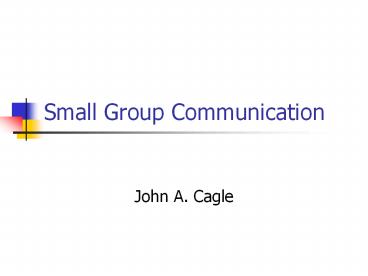Small%20Group%20Communication PowerPoint PPT Presentation
Title: Small%20Group%20Communication
1
Small Group Communication
- John A. Cagle
2
Deweys Reflective Thinking
- In 1910, John Deweys How We Think introduced a
rational model of solving problems and making
decisions called Reflective Thinking. - This approach would later become the standard
agenda teachers of group discussion would use to
teach students how to work in groups.
3
Procedural Model of Problem Solving (PMOPS)
- What is the nature of the problem facing us?
- What might be done to solve the problem?
- What are the relative merits and demerits of the
possible solutions? - What is the best decision we can all support?
- How will we put our solution into effect?
- How can we prepare an effective written and oral
report?
4
Lewins Field Theory Systems Theory
- Kurt Lewin introduced us to idea of field theory,
an early systems theory - Group variables are related to other variables so
that by altering or manipulating one variable
changes are produced in all other variables.
5
Collins Guetzkows Model of Decision Making
- task groups encounter two types of obstacles,
task and interpersonal - the group produces behaviors related to those
obstacles - those behaviors contribute to the groups final
output and productivity, and - two rewards result in the end that determine what
behaviors will be learned and maintained in
response to future obstacles.
6
(No Transcript)
7
(No Transcript)
8
Robert F. Bales Interaction Process Analysis
(IPA)
- A group members communication reveals aspects
of his/her personality. - He thus developed a system for systematically
measuring communication behaviors in groups
called IPA (Interaction Process Analysis). - Communication is linked to group task and
socio-emotional effectiveness and satisfaction. - Perceptions of a group members communications
produce perceptions of leadership and liking in
other group members.
9
Bales Interaction Process Analysis
Positive socio-emotional Seems friendly
Positive socio-emotional Dramatizes
Positive socio-emotional Agrees
Task attempted answers Gives suggestion
Task attempted answers Gives opinion
Task attempted answers Gives information
Task attempted questions Asks for information
Task attempted questions Asks for opinion
Task attempted questions Asks for suggestion
Negative socio-emotional Disagrees
Negative socio-emotional Shows tension
Negative socio-emotional Seems unfriendly
10
Benne and Sheats
- Communication enables the group to accomplish
task and social goals. - In fulfilling such needs, a communication serves
a function for the group. - In terms of Task and Social/Maintenance, various
communication roles are enumerated in the theory.
11
Illustrative Leadership Behaviors
Task Messages
Relationship Messages
- Information opinion giver
- Information opinion seeker
- Direction and role definer
- Summarizer
- Energizer
- Comprehension checker
- Encourager of participation
- Communication facilitator
- Tension reliever
- Process observer
- Interpersonal problem solver
- Supporter and praiser
12
More TaskMessages
Fewer
Low Dominance
High Dominance
More RelationshipMessages
acquiescesagreesassistsconcursobligesconced
esevadesrelinquishesretreatswithdraws
advisescoordinatesdirectsinitiatesleadsanal
yzescriticizesdisapprovesjudgesresists
High Sociability
Low Dominance
Fewer
13
(No Transcript)
14
(No Transcript)

